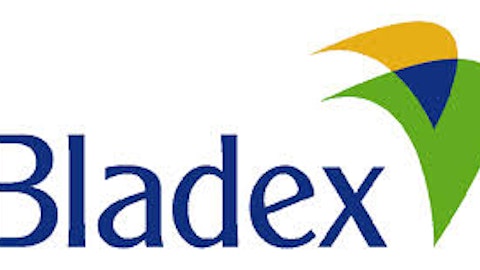So interest rate levels in the U.S. do affect – direct effect on our spreads. I’m going to turn the – Annie can probably give a more detailed answer and perhaps when we talk about base rates and how we’re looking at them. And then when we think about spreads, I’m going to turn it to Samuel for more of a short-term view of what we’re seeing this year in terms of spreads in the region. Annie, do you want to tackle?Ana Mendez Yes. Thank you, Ngo. Good day. And yes, I know you mentioned to live out the effect of a U.S. dollar interest rate, but like Jorge said that’s a big portion. Like Eduardo just mentioned before, we did position the bank towards late 2021 and the beginning of 2022 with that – an important amount of debt that we place at fixed rates and that are going to reprise even beyond next year.
And continuously we have seen that the increases in interest rates as they are laddered, they have had an increasing impact, a positive impact in our net interest margin over the last several quarters. We actually saw that peak this quarter. And like Eduardo just mentioned, that differential today amounts to about 25 basis points, which is in terms of net interest margin.As interest rates level off, we should start to see some pickup in terms of the funding costs, but it’ll also take time because of the maturities of the debt that we have going forward. And in terms of the base rate differentials as well as the spread that I’m going to give the word to Sam, now. You have to remember that every quarter we have a turnover of our book of about half or even more than half of the book that’s maturing the loan book and a lot of it happens also on our liability side.
So we are definitely able to pick up any trends both in our base rates or market rates and in our spreads. Like Eduardo said, we do see stable spreads in our funding cost. We haven’t seen any increase there even recently with the recent turmoils in the financial sector in the U.S. and Europe. And now, I can give Sam, the word now to talk a little bit about our lending spreads, which we also saw increase importantly over the last several quarters particularly in the boom of commodity prices of last year. Sam, please.Samuel Canineu Sure. I think first of all, when we look at – and Annie touched on this point, when we look at our business model, given the very short tenor of our book, it’s hard to make any prediction on, let’s say, medium term spread because it can change very fast upwards as we’ve seen and of course, downwards depending on the market condition.
What I can say is that everything and back a little bit about the strategy that we’ve been doing is about creating – increasing our cost opportunities, increasing recurrency in our loan book to be less subject to changes in market conditions even for the short-term book.I would say the level of spread that we have reached up to now has a lot to do with the changes, I would say in our business model and improvement of our business model, all the new clients we have added as well as of course capturing the market conditions, particularly the increasing commodity price. We saw the first quarter and this year of a lower demand across the region because of the just economic environment, lower prices of commodities. But we were still able to sustain margins because of – we just have more clients now to choose from.
I think, when I look the next quarters, I think, I don’t see as much as upside in increasing margins because we’re not changing our credit profile on country. We’re very aware of what’s going on, and we’re not going to take more risks than desired. So the challenge and the objective is to sustain the current spread that we have been achieving so far. And I think we have been doing a good job so far, and I don’t expect to change materially from that. Jorge Salas Hope that answers your question, Ngo. I would only stress the ability of this bank, given the short-term nature of the – and the repricing to shift from slightly asset sensitive to liability sensitive in case we see the rates pivoting in one way or another.Unidentified Analyst Super clear.
Thank you very much.Jorge Salas Thank you.Operator Okay. Thank you very much. Our next question is a voice question from Andrea Atuesta from Bancolombia. Please go ahead, ma’am. Your line is open.Andrea Atuesta Hello, good morning, and thank you for taking my question. I just have one question [indiscernible] taking into account the positive dynamics of the results at the beginning of 2023. Can you please repeat the guidance of your main indicators by the end of the year? And I also want to know if these guidance contemplate the new trends and the recovery of the international trade that we are beginning to watch in Latin America. Thank you very much.Jorge Salas Thank you, Andrea for your question. I’m going to start by the last part first.
GDP growth for Latin America will be slowing down. This year we expect 1.2% GDP growth, two more in the order of 2% for 2024 according to the IMF. So we see a slowdown – GDP growth slowdown in the region. On the other hand, trade for the region, imports plus exports is estimated to grow 2% this year and almost 4% next year. So that as far as a region and I must say that trade levels in Latin America are at record highs, trade in 2022 was almost $3 trillion, not 57% higher than what we had in 2020 and almost 30% higher than what we had pre-pandemic. So trade is a very important driver for us and its – our record levels end growing this year.As far as like our guidance for 2023, as I mentioned, capital will remain between 15% and 16%, net interest margin we mentioned between 2.1% and 2.4%.
We’re already at the higher end of that range. Fees as Annie mentioned before, growing between 8% and 10%. They have done traditionally, and that includes syndication and letters of credit fees. Efficiency is current. It is still improving, but it’s even better than our – than we originally anticipated because of the increase in revenues. And what we did change was our ROE for the year, we initially said between 10% and 11%. And now we’re saying giving what we’re seeing and especially our first quarter, our results more in line with between 11% and 13% for the year, that’s our guidance. Do you have any additional questions? Hope that answers your questions.Operator Thank you very much. We’ll be now moving to text question from Mr. Ricardo Vallarino, individual investor.
Congratulations on an excellent record setting quarter. Two things that really jumped out to me were the efficiency ratio of 26.9% and net interest spread of 1.82%. Could you elaborate on how you see these two behaving for the rest of your strategic plan?Jorge Salas I think we touched on that before. The way the plan is designed Ricardo is to take advantage of the spread now, of course, while they are there, we have achieved a more efficient capital level. We have increased our customer base. Cross-sell is also improving. But the real key to the plan is, what I mentioned before regarding additional fee income on treasury products, and also structure, trade finance, supply chain finance type solutions, that is where we were going to have additional margins and you’re going to see and that’s what we’re working on now, and that should compensate for headwinds in the future.
So we do see – we are confident that we are executing our plan as we thought and we do believe that we will achieve mid-teens ROEs in a sustainable manner by 2026.Operator Thank you very much for the answer. Our next question is a voice question from Mr. Jim Marrone from Singular Research. Please go ahead, sir. Your line is open. Just once again, Jim Marrone from Singular Research, we detected question from your line. Your line is open. Please go ahead.Jim Marrone Yes. Thank you for taking my call. You may have touched upon it again, but if you could just reiterate. You did a great job in managing the book. You’ve explained well the interest rate sensitivities on both your assets and liabilities, but if you could just provide a little bit of color in terms of your client’s books, what are you hearing from your clients in terms of higher rates, the inflation impact and the increased risk of perhaps default and Bladex approach to perhaps higher credit risk going forward with regards to your provisions.
If you could just provide a little bit of color on what you’re hearing from clients in terms of their books, as well as your approach to handling the book? Thank you.Jorge Salas Let me just say a couple things and then I’ll turn it to our Head of Commercial Unit, Sam Canineu. I mean there’s no doubt that sustaining this level of interest rates will have a credit effect on clients that are over-leveraged in the region. And our plan, accounts for that and our level of provisions account for that. Good news is that we have the ability to shift our exposures to clients that are less leveraged in case we need it in different countries and in different sectors.As far as interest rates in the U.S. and our clients accessing capital markets, we are also seeing some of that recently.




